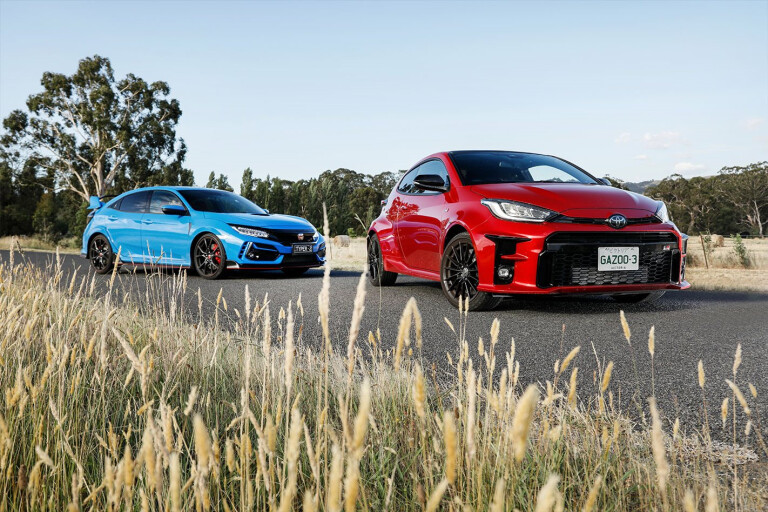
Ding, ding, ding! And now for the main event. Today’s fight is for the title of world’s best driving hot hatch and the judge’s decision is final.
Both our combatants have Japanese heritage, though one is UK-born, and in an unusual move we’re mixing weight divisions.
In the blue corner is the reigning champion, the middleweight Honda Civic Type R, weighing in at 1396kg.
It’s here in freshly facelifted guise, but don’t expect any sweeping changes to its vital statistics.
The 2.0-litre turbocharged four-cylinder still produces 228kW at 6500rpm and 400Nm from 2500-4500rpm, attached to a six-speed manual and driving the front wheels through a limited-slip differential.
Instead, Honda’s engineers have made subtle tweaks to the training regime of their benchmark hot hatch, examining every nut and bolt in search of improvement.
New control software for the adaptive dampers allows them to read the road 10 times quicker; the bushes in the rear lower B-arm have been stiffened by eight per cent for “better toe-in characteristics when cornering”; the front compliance bushes are 10 per cent stiffer and friction in the ball joints has been reduced.
New two-piece floating front brake discs shed 2.3kg – with the added benefit of it being unsprung weight – and the brake pads feature a more fade-resistant material.
The pedal stroke has also been reduced by 15mm for improved response. Revised styling includes symmetrical fog light surrounds, a new grille increases the intake air opening by 13 per cent, which when combined with an uprated radiator core reduces coolant temperature.
Inside, the steering wheel is now wrapped in Alcantara, a teardrop-style gearknob – a nod to earlier Type R models – replaces the previous sphere, the infotainment has been updated and new Active Sound Control software makes the engine sound ‘sportier’.
A data logging app has been installed to help drivers improve their lap times, though it can also score your day-to-day driving based on how smoothly you operate the steering, brakes and throttle.
Prices have increased slightly, too, with the MY20 Civic Type R now starting at $54,990.
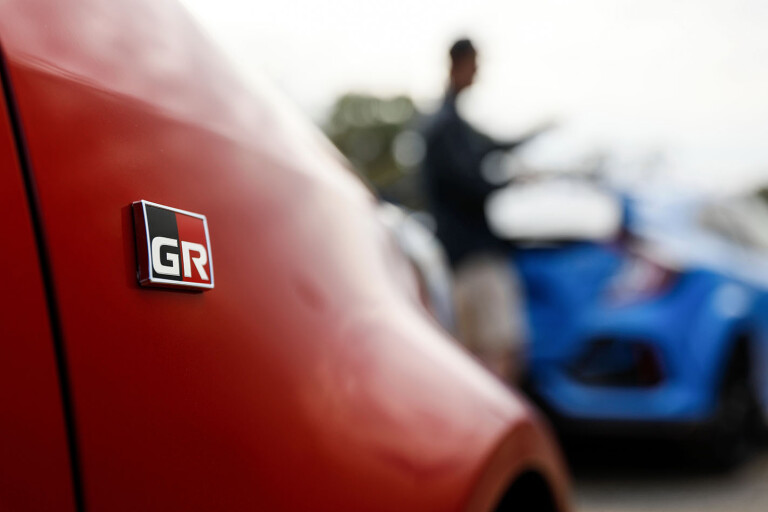
In the red corner is its opponent, the Toyota GR Yaris, a lightweight at 1280kg.
It’s one of the most hotly anticipated performance cars, well, ever, and with good reason, for it’s the first solely Toyota-developed performance car in more than two decades. Like the Japanese giant’s last effort, the ST205 Celica GT-Four, the GR Yaris is a homologation special, designed to form the ideal basis for the 2021 Yaris World Rally Car.
Sadly, COVID-19 denied teams the chance to test, which means the competition version will never see the stages.
As such, Ogier, Evans and Rovanpera won’t reap the rewards of the GR’s clever engineering but customers will.
Virtually everything about this all-paw Yaris is bespoke; Toyota claims just three components – headlights, taillights and mirrors – are common to the more sensible sibling that shares its name.
The platform joins the front of a Yaris (Toyota’s GA-B platform) to the rear of a Corolla (GA-C) with a carbon fibre roof and the use of aluminium for the doors, bonnet and tailgate, the combination of which saves 27.6kg.
The roof is lower to improve aerodynamics, multi-link independent rear suspension is installed and the all-wheel drive system, which features an electronically controlled multi-plate clutch ahead of the rear diff, appears only in the GR Yaris.
Likewise the engine, a 1.6-litre turbocharged three-cylinder producing an amazing 200kW at 6500rpm and 370Nm from 3000-4600rpm.
The Honda’s greater output gives it the power-to-weight advantage but only just, 163kW/tonne to the Toyota’s 156kW/tonne, though torque-to-weight is almost identical – 287Nm/tonne and 289Nm/tonne respectively.
All this high technology doesn’t come cheap, however.
The Yaris retailing for $49,500, though the first 1000 customers scored a bargain at $39,950 driveway and another 100 did OK at $44,950 driveaway.
Anyway, with the weigh-in completed, it’s over to Michael Buffer: “Let’s get ready toooo ruuumblllllleeee!”
On the drag strip, the GR’s all-wheel drive system gifts it straight-line superiority, against the clock at least.
As with all cars of this type, launching it is a fairly brutal process.
Banging the three-pot off the rev limiter appears to trigger a protection mode, the engine bogging down when the clutch is released, but flooring the throttle and sidestepping the clutch as the revs rise to about 5500-6000rpm lights up all four tyres and the Yaris shoots off the line like it’s sat on a cactus.
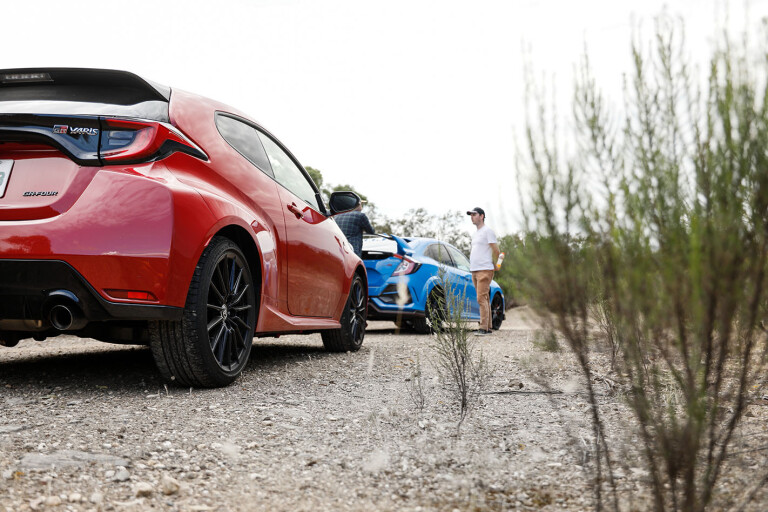
The gearing couldn’t be worse for the 0-100km/h sprint, second running out at 98km/h and necessitating a second shift, but triple figures come up in 5.16sec regardless. Impressive.
The charge continues through 400m, the run completed in 13.2sec at 169.74km/h. Yep, point this baby at a drag strip and you should see a 12-second quarter.
Hamstrung by two driven wheels, the Civic can’t compete. It launches well for a front-driver, traction remarkably strong given the power and torque, but like the Yaris a second gearshift is required before 100km/h.
Both cars would shave two or three tenths from their times with fractionally longer second gears, but are presumably set up to nail the international 0-60mp/h (97km/h) standard.
The Honda hits 100km/h in 5.81sec but from there starts to bite chunks out of the Toyota’s lead; it still trails at the quarter-mile mark, taking 13.79sec, but the 173.12km/h trap speed shows the Type R’s extra grunt is beginning to show, accelerating from 100-170km/h in 7.54sec compared to 8.07sec for the Yaris.
The Civic has the fractionally superior overtaking urge, taking 2.9sec to shoot from 80-120km/h in third gear compared to the Yaris’s 3.0sec, but it’s the Toyota that feels fitter on the road.
This three-cylinder engine is incredible, powered not so much by fuel and air as witchcraft and whimsy.
A fun game: if you have a passenger who knows cars but not the Yaris itself ask them what engine they think it has. A turbo four is the obvious choice but the soundtrack suggests six cylinders; it’s clearly not a three-cylinder, not with this level of performance. That’s impossible.
Except, somehow, it is possible.
This remarkable turbo triple pulls hard to beyond the 7000rpm redline but it’s the response that is uncanny; it doesn’t really matter what gear you’re in or how many revs are showing, floor the throttle and you’re rewarded with virtually instant urge.
This remarkable flexibility means rowing the gearbox isn’t a necessity but doing so is no chore, as the shift is accurate and mechanical in its feel.
While some testers have noted difficulty, heel-toeing it’s not a problem personally and you’ll want to do so, as the rev-match system is unable to keep up with quick downshifts.
Sonically the engine is...interesting – it doesn’t produce a particularly beautiful noise but nor is it unpleasant. It even coughs lazily into life like a highly tuned rally car.
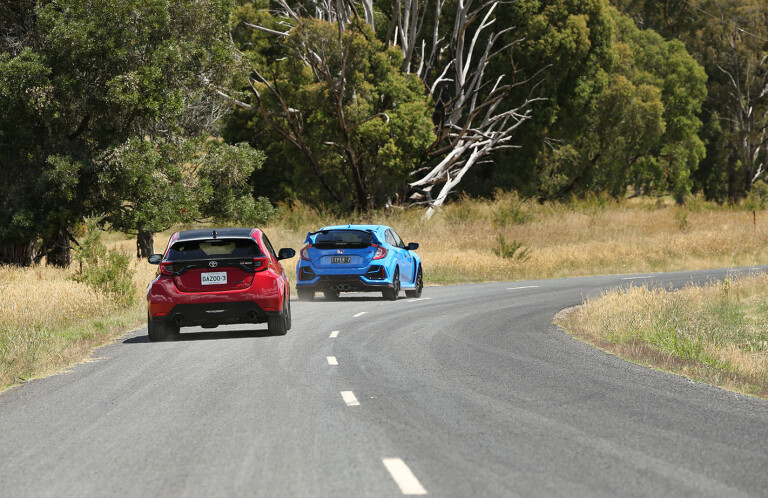
The Honda’s four-cylinder is less enticing, emitting a tuneless buzz, though the ‘pchew’ from the turbo wastegate when lifting off under full noise is a joyous sound.
It’s an effective rather than inspiring engine; very effective, it must be said, and capable of providing a serious turn of speed
There’s a moment’s hesitation, however, as the turbo wakes up a lower rpm and power tails off noticeably once the 6500rpm peak has passed. It can hang onto the Yaris, but only just.
Helping the cause is the incredible gearshift; a tenth or more is saved on every shift as the lever flies to the next ratio as quickly as you can move your hand and feet, almost like it’s making its way there of its own accord.
I can guarantee you’ll flit up and down the gearbox needlessly just for the pleasure of changing gear and the new teardrop gear knob fits your hand beautifully (though fellow tester Inwood isn’t a fan).
Honda’s rev-match system works faultlessly, but should you burrow your way through the various sub-menus and turn it off you’ll find it largely redundant as the gearbox and engine work so well together that seamless heel-toe downshifts soon become second nature.
Those familiar with previous Type Rs and their screaming 8000rpm+ engines will no doubt find this latest Civic’s turbo unit a little uninspiring, but in the FK8 it exists purely to propel one of the most capable front-drive chassis ever created.
Actually... make that the most capable chassis of any drive configuration.
If Porsche were ever to create a front-wheel-drive Cayman the FK8 CTR is probably pretty close to what it would feel like. Dynamic praise doesn’t come much higher.
Nothing flusters this car. No matter the corner, the camber, the surface, it just soaks it up and laughs at your lack of commitment: “Oh, you thought I was going to understeer? Try again, you wuss, and put some effort in this time.”
The steering is meaty, the weight increasing as you cycle through the Comfort, Sport and R+ drive modes, but the heft feels natural and it controls a front end with the pinpoint accuracy of a laser-guided ballistic missile.
The Civic’s resistance to understeer borders on the supernatural and getting on the throttle actually tightens your line, dragging the nose further into the apex.
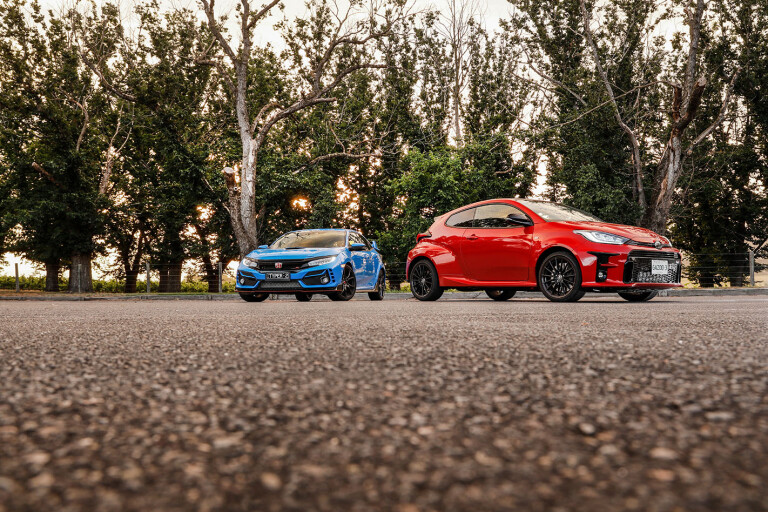
Cornering speeds are absurd but the Type R isn’t some locked-down automaton; the driver still feels a key part of the process and an appropriately timed throttle lift or brush of the brake mid-corner loosens the rear slightly just to let you know the option’s there if you need it.
Which you won’t, for there are few cars that can tear a road apart with the efficiency of the Honda.
Switch to the Yaris and the first impression isn’t a positive one. The platform might be a meld of Yaris and Corolla but the seating position appears to have been taken from the HiLux.
Like the Focus RS, all the controls are well located but appear to be 10cm too high; the diminutive Toyota is a whopping 562mm shorter (in length) and 72mm narrower than the Honda but actually stands 21mm taller, giving the impression that it could topple over in a strong wind, at least from the rear.
Nevertheless, the leather-wrapped wheel makes the Civic’s Alcantara helm feel a size too big and the – likewise leather-wrapped – gear lever and manual handbrake (yay!) are well within reach.
Initially, our test road is fast and flowing and the Yaris feels right at home. The seating position does cause a slight disconnect but the sensation fades with familiarity and in these quick corners it feels great.
Its size gives you more of the road to work with, the engine always has plenty of punch and there’s a sensation of stability and agility at the same time.
The steering is slower than the Honda’s – 2.36 turns lock-to-lock versus 2.11 – but the weighting feels right and it’s linear and accurate in its responses.
You relish the thought of the first real bend, an opportunity to lean hard on this road-going rally car. A firm press on the middle pedal engages the fantastic brakes; 356mm two-piece rotors and four-piston calipers at the front and 297mm discs with two-piston calipers at the rear are overkill on a 1280kg car and that’s exactly how it should be.
Down a gear, turn the wheel and... oh dear. The front tyres screech as they slide wide of the desired trajectory and adding throttle only overburdens them further, the ESP working overtime to keep the car stable.
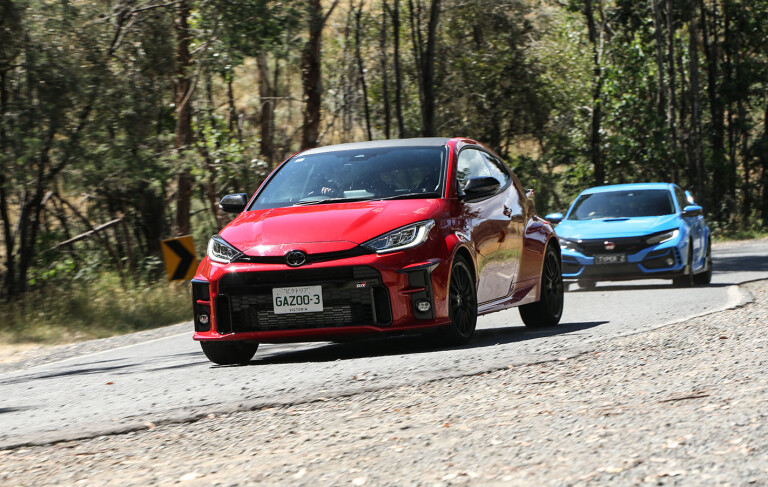
Turning the drive mode controller to the left engages Sport mode, which adjusts the drive split from 60:40 front-to-rear to 30:70, and a press of the ESP button slackens the electronics into ‘Expert’.
The power understeer is lessened but the reluctance to turn in the first two-thirds of the corner remains. It’s said that cars don’t understeer until drivers make them and there is an element of truth in that, but it’s also true that the front tyres of the GR Yaris are a fuse that trips well before expectations.
It’s still a quick car and the suspension does a great job of soaking up bumps and keeping the body under control, but you’re soon left with no option but to alter your driving in an attempt to coax the best from the Yaris.
Following in the Civic it’s very amusing watching Inwood try every trick he knows in an attempt to get the Toyota to do his bidding and he reports similar entertainment when following me.
Loosening the rear on entry is possible on certain corners, but doing so mid-turn kills forward momentum.
Eventually, you accept the fact that the most efficient way to drive the Yaris is slow-in, get the car rotated toward the exit, and then power out as straight as possible.
Funnily enough, that’s usually the technique required for high-powered front-wheel drives, whereas the Civic can be driven like a well-sorted all-wheel drive: commit hard on entry, hit the power early and drag yourself out of the corner.
Inwood neatly summarises the gulf between these two car’s abilities: “You’re still on the brakes in the Yaris when I want to be on the throttle in the Civic.”
The Honda continues to impress when the roads straighten, the heart rate slows and the drive mode selectors are clicked to ‘calm’ rather than ‘qualifying’.
Even in its sportiest R+ mode it rides fairly well, but in Comfort it is truly plush, absorbing all manner of road imperfections. The seats are extremely comfortable, too, front and rear, which makes for relaxing progress.
This is just as well, as the Civic has some very annoying traits.
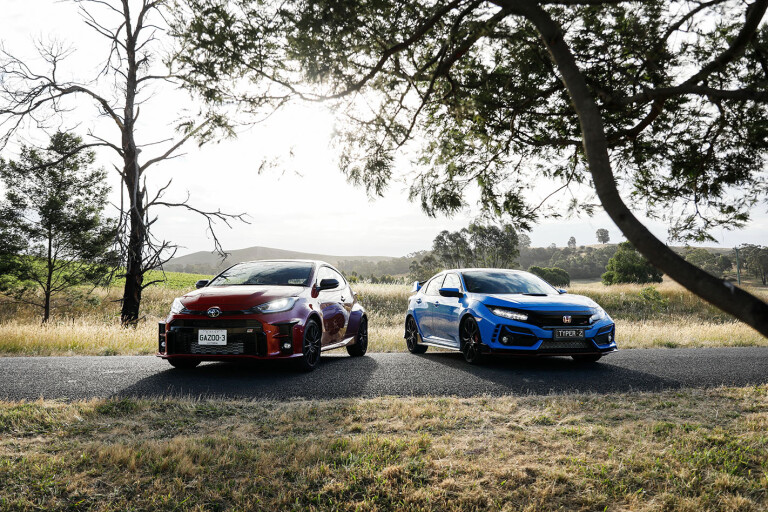
Honda has made an effort to improve its sub-par dash ergonomics, installing hard keys for various infotainment menus and fan speed and a proper volume knob, but the unit itself still looks ordinary, functions are buried in sub-menus and you often need to be stopped with the handbrake on in order to access them.
The top of the Apple CarPlay screen is also obscured by climate control info, which often means crucial buttons aren’t accessible.
The digital temperature and, more importantly, fuel gauges are hard to read and you don’t have to search very hard to find hard, shiny plastic – it’s there every time your fingers touch the back of the steering wheel.
There are only two seats in the back and it’s a pretty bare environment, too, but there is plenty of space and the boot is an impressive 420 litres (1209L with the rear seats folded).
One final gripe: the 46-litre fuel tank is way too small when a mix of enthusiastic and highway driving yielded an average consumption of 14.25L/100km.
In terms of liveability, however, the Civic is streets ahead of the heavily compromised Yaris.
The GR’s rear seats have space for children but that swoopy, slippery roof means there’s insufficient headroom for anyone over about 150cm.
Likewise, that three-door body pays dividends in the WRC but it makes those rear seats tricky to access.
You’re better off dropping the rear backrests and turning the GR into a two-seater, as this expands boot space from a laughable 141 litres to 737 litres.
The Yaris is loaded with equipment, from active safety kit like adaptive cruise control, (sadly annoyingly intrusive) lane keep assist, autonomous emergency braking with pedestrian detection and speed sign recognition, as well as an excellent head-up display, dual-zone climate control, sat-nav and heated seats.
Toyota has made sure the important touchpoints feel good – the aforementioned leather wheel, gear knob and handbrake – but the vast majority of the interior is a sea of hard plastic that says $20,000, not $50,000.

This wouldn’t matter one bit if the driving experience was transcendent, but it isn’t – not even close.
The engine is a thing of wonder, the gearshift is enjoyable, it’s the right size, the brakes are fantastic, but the total is less than the sum of the parts.
Following a drive of the GR Yaris prototype last year I wrote: “At $35,000 or so [it] has the potential to be the hot hatch king, but add $10K and it could be the court jester, talented and amusing but ultimately a bit player.”
Nothing in the finished product changes that view. Those who scored one at $39,950 driveaway did well, but at its usual $49,500 MSRP (before on-roads) there is just too much opposition that offers much greater practicality and, crucially, more enjoyable dynamics.
It reminds me, in fact, of a modern-day Subaru WRX GC8.
There is hope for the Toyota, however. With grippier Michelin Pilot Sport 4 S tyres replacing the (sub) standard Dunlops, revised suspension and a limited-slip differential at each end, the forthcoming Rallye could fulfil the GR’s potential.
We hope so, because Toyota deserves credit for building this exotic hot hatch and we want it to be great.
But it’s going to have to be really, really good to take the fight to the Civic Type R.
Not everyone will be able to get over the way it looks – though Inwood and I both like it: it’s distinctive, suits the car’s personality and the new Racing Blue paintwork certainly helps – and the interior annoyances are a pain but to drive it’s mind-blowing.
It is so fast, so controlled, so immersive that this fight doesn’t even need a judge’s verdict: it’s a knockout to the Honda.
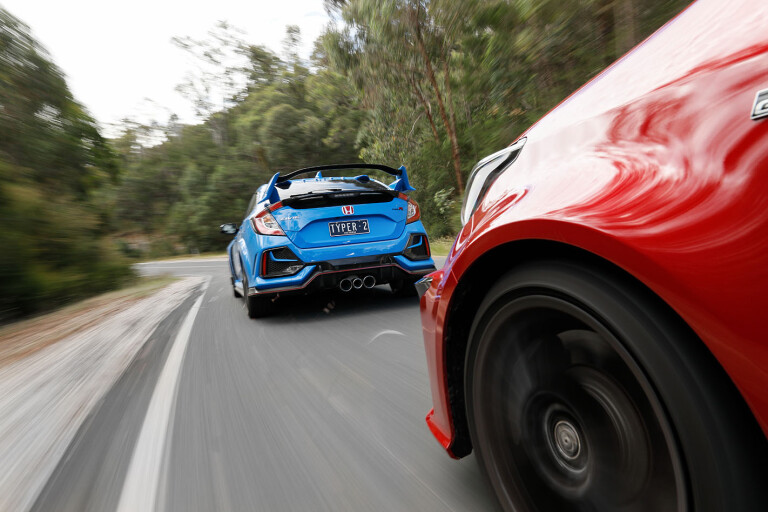
VERDICT
1st Honda Civic Type R: 4.5/5 stars
- Pros: Unbelievable chassis; ride quality; gearshift
- Cons: Infotainment; engine top end; small fuel tank
2nd Toyota Yaris GR: 3.5/5 stars
- Pros: Amazing engine; ride; right size; image
- Cons: Understeer; seating position; interior; price
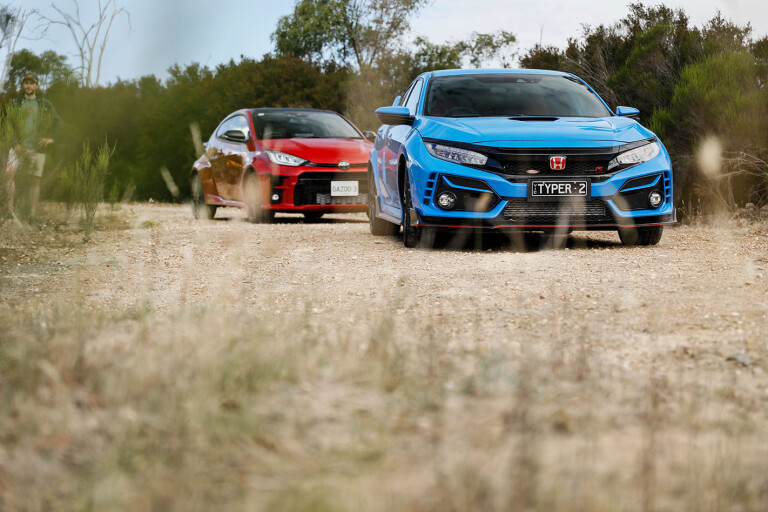
SPECIFICATIONS
Toyota Yaris GR
| Body: | 3-door, 4-seat coupe |
| Drive: | all-wheel |
| Engine: | 1618cc inline-3cyl, DOHC, 12v, turbocharger |
| Bore x Stroke: | 87.5 x 89.7mm |
| Compression: | 10.5:1 |
| Power: | 200kW @ 6500rpm |
| Torque: | 370Nm @ 3000-4600rpm |
| Power/Weight: | 156kW/tonne |
| Transmission: | 6-speed manual |
| Weight: | 1280kg |
| Suspension: | struts, coil springs, anti-roll bar (f); multi-links, coil springs, anti-roll bar (r) |
| L/W/H: | 3995/1805/1455mm |
| Wheelbase: | 2560mm |
| Tracks: | 1535/1565mm (f/r) |
| Steering: | electrically assisted rack-and-pinion |
| Brakes: | 356mm ventilated two-piece discs, 4-piston calipers (f); 297mm ventilated discs, 2-piston calipers (r) |
| Wheels: | 18 x 8.0-inch (f/r) |
| Tyres: | 225/40 ZR18 100Y (f/r) Dunlop SP Sport Maxx |
| Price: | $49,500 |

Honda Civic Type R
| Body: | 5-door, 4-seat coupe |
| Drive: | front-wheel |
| Engine: | 1996cc inline-4cyl, DOHC, 16v, turbo |
| Bore x Stroke: | 86.0 x 85.9mm |
| Compression: | 9.8:1 |
| Power: | 228kW @ 6500rpm |
| Torque: | 400Nm @ 2500-4500rpm |
| Power/Weight: | 163kW/tonne |
| Transmission: | 6-speed manual |
| Weight: | 1396kg |
| Suspension: | struts, coil springs, adaptive dampers, anti-roll bar (f); multi-links, coil springs, adaptive dampers, anti-roll bar (r) |
| L/W/H: | 4557/1877/1434mm |
| Wheelbase: | 2699mm |
| Tracks: | 1584/1602mm (f/r) |
| Steering: | electrically assisted rack-and-pinion |
| Brakes: | 350mm ventilated two-piece discs, 4-piston calipers (f); 305mm solid discs, single-piston calipers (r) |
| Wheels: | 20 x 8.5-inch (f/r) |
| Tyres: | 245/30 ZR20 (f/r) Continental SportContact 6 |
| Price: | $54,990 |
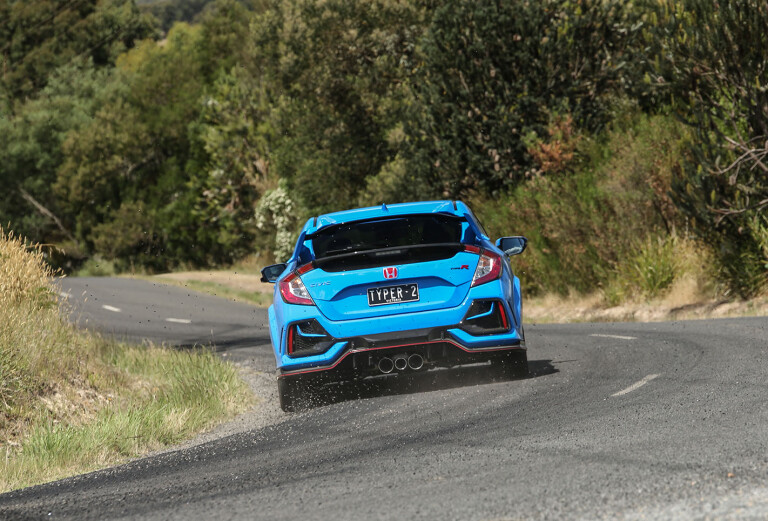
PEFORMANCE TESTING
| HONDA CIVIC TYPE R | TOYOTA YARIS GR | ||
| ACCELERATION | ACCELERATION | ||
| 0-10km/h | 0.49 | 0-10km/h | 0.24 |
| 0-20km/h | 0.98 | 0-20km/h | 0.59 |
| 0-30km/h | 1.53 | 0-30km/h | 0.94 |
| 0-40km/h | 1.98 | 0-40km/h | 1.28 |
| 0-50km/h | 2.48 | 0-50km/h | 1.63 |
| 0-60km/h | 2.48 | 0-60km/h | 2.06 |
| 0-70km/h | 3.66 | 0-70km/h | 2.86 |
| 0-80km/h | 4.19 | 0-80km/h | 3.42 |
| 0-90km/h | 5.01 | 0-90km/h | 4.04 |
| 0-100km/h | 5.81 | 0-100km/h | 5.16 |
| 0-110km/h | 6.54 | 0-110km/h | 5.95 |
| 0-120km/h | 7.32 | 0-120km/h | 6.78 |
| 0-130km/h | 8.48 | 0-130km/h | 7.73 |
| 0-140km/h | 9.56 | 0-140km/h | 9.13 |
| 0-150km/h | 10.71 | 0-150km/h | 10.37 |
| 0-160km/h | 11.92 | 0-160km/h | 11.70 |
| 0-170km/h | 13.35 | 0-170km/h | 13.23 |
| 0-400m 13.79sec @ 173.12km/h | 0-400m 13.20sec @ 169.74km/h | ||
| 80-120km/h | 2.9sec (3rd) | 80-120km/h | 3.0sec (3rd) |
| 100-0km/h | 35.8m | 100-0km/h | 34.92m |
| SPEED IN GEARS | SPEED IN GEARS | ||
| 1st 58km/h @ 7000rpm | 1st 62km/h @ 7200rpm | ||
| 2nd 99km/h @ 7000rpm | 2nd 98km/h @ 7200rpm | ||
| 3rd 137km/h @ 7000rpm | 3rd 143km/h @ 7200rpm | ||
| 4th 187km/h @ 7000rpm | 4th 189km/h @ 7200rpm | ||
| 5th 231km/h @ 7000rpm | 5th 230km/h @ 6920rpm* | ||
| 6th 272km/h @ 6650rpm* | 6th 230km/h @ 5780rpm* | ||
| *Manufacturer's claim | |||
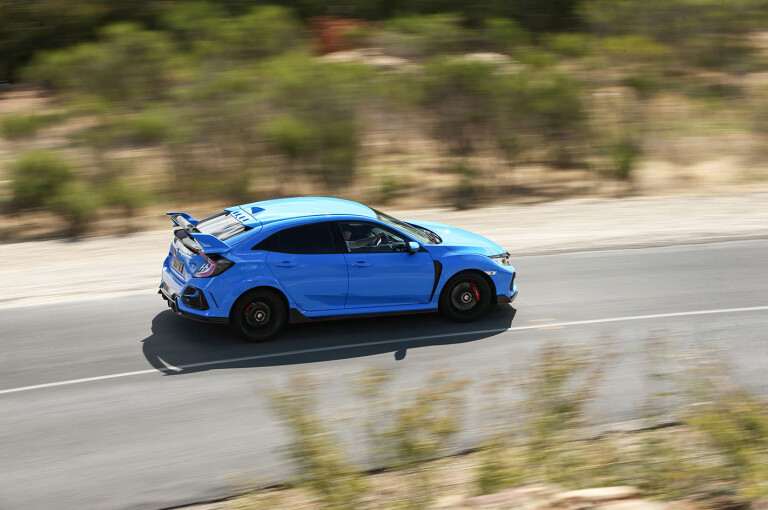

COMMENTS